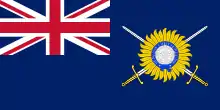Indian Army Service Corps
Indian Army Service Corps (IASC) is a corps and an arm of the Indian Army which handles its logistic support function. While the history of supply and transport services is as old as the history of organized warfare itself it was in 1760 that the very rudimentary supply and transport organizations of the three presidencies of the East India Company were brought under the council of a single authority.
| Indian Army Service Corps | |
|---|---|
 Logo of Indian Army Service Corps. | |
| Active | 1760-Present |
| Country | |
| Allegiance | |
| Branch | |
| Role | Military Logistics |
| Regimental Centre | Bangalore, Karnataka |
| Motto(s) | SEVA ASM AKAM DHARMAHA |
| Anniversaries | December 8 (Corps Raising Day) |
| Engagements | First World War Second World War Indo-Pakistani War of 1947 Indo-Pakistani War of 1965 Indo-Pakistani War of 1971 Indo-Pakistani War of 1999 |
| Decorations | • PVSM-15 • MVC-1 |
| Battle honours | Colonel of the Regiment- Maj.Gen. Arvind Katoch |
| Insignia | |
| Flag |  |
Role and non-operational status


The Army Service Corps is mainly responsible for the provisioning, procurement and distribution of supplies of food ration, fresh & dry eatable items, FOL (fuels, oil, lubricants), hygiene chemicals and items of hospital comforts to Army, Air Force and when required Navy and other paramilitary forces. Other responsibilities include the operation of mechanical transport except first line transport and fighting vehicles. ASC is responsible for provision and operation of first and second line animal transport; carriage and distribution of ammunition including mines; corps maintenance area in case of plains, divisional maintenance area in case of mountain formation; packing of commodities for supply; loading of aircraft and ejection of loads; training and provisioning of clerks for all branches of staff at formation headquarters; training and provisioning of catering staff in the army; and postal services in forward areas.
Officers in the Army Service Corps are not considered combatant officers by the Army. Officers from the Army Service Corps along with other services corps believe their designation as "non operational" is discriminatory, depriving service corps officers of the pay and promotion opportunities of combat officers. In 2017, the media reported widespread insubordination among service corps officers who refused to accept field postings in forward and counter-insurgency areas due to claims of discrimination.[1]
History
The origin of the corps go back to 1760 when a Commissariat used to exist in the administrative component of the armies three Presidencies of Bengal, Madras and Bombay. In 1878 the separate Commissariats were amalgamated into a single entity and then in 1901 it was renamed the Supply and Transport Corps. During the First World War the corps became a permanent component of the British Indian Army and was renamed the Indian Army Service Corps in 1923. In 1935 the corps was granted the 'Royal' prefix and became known as Royal Indian Army Service Corps (RIASC).
After India gained independence in 1947, the corps underwent further expansion and by 1948 Indian Catering Corps and Indian Army Corps of Clerks were amalgamated into the corps. The Food Testing Laboratories were also placed under the control of RIASC. On 8 December 1950, after India became a republic, the corps dropped the use of the 'Royal' prefix and was once again renamed the Indian Army Service Corps. Since that day the corps has celebrated its Raising Day on 8 December. On 8 December 1967 the first colours of the ASC were presented by President Zakir Hussain.[2]
References
- "Divided Force". The Week. December 31, 2017.
- "ASC celebrates 251st Corps Day". The Telegraph (Calcutta). December 9, 2003.